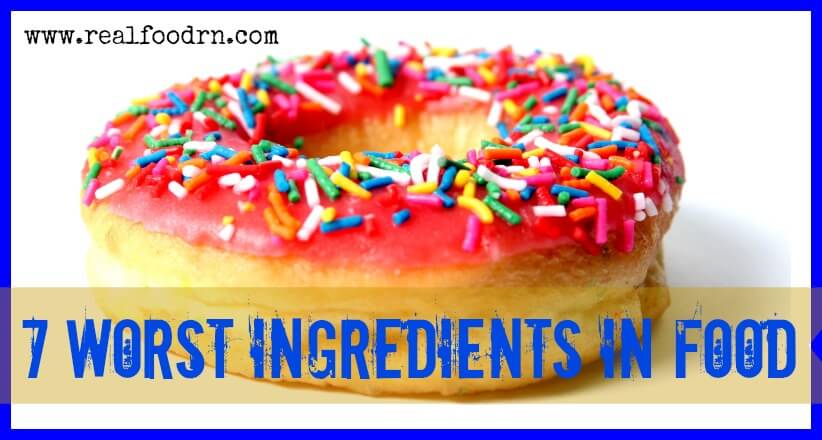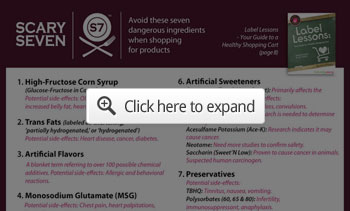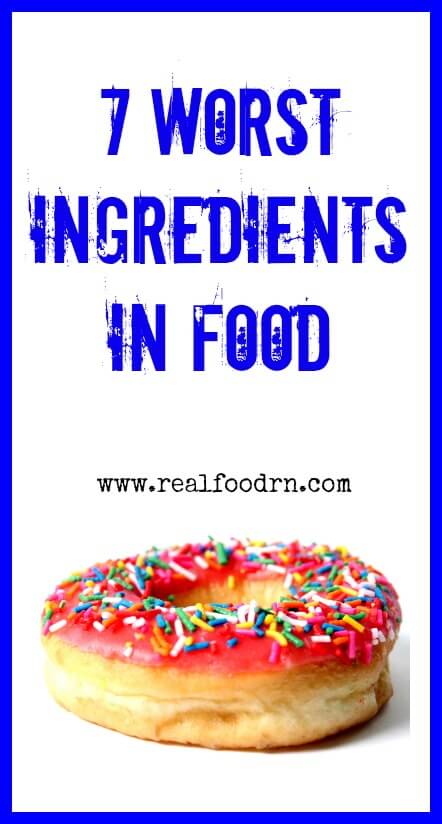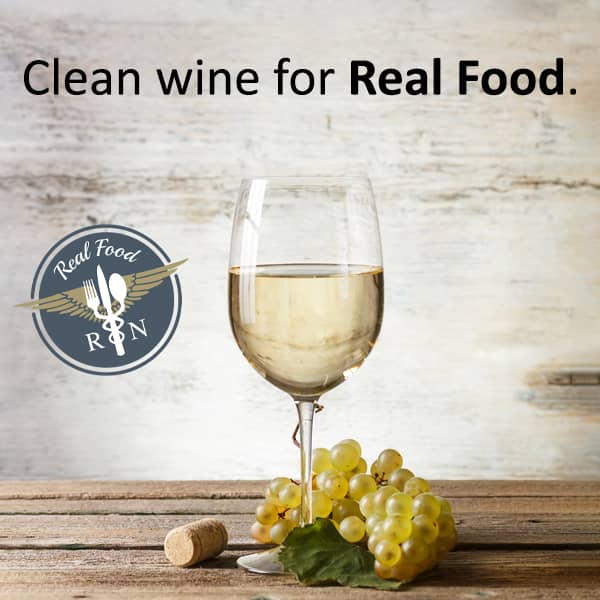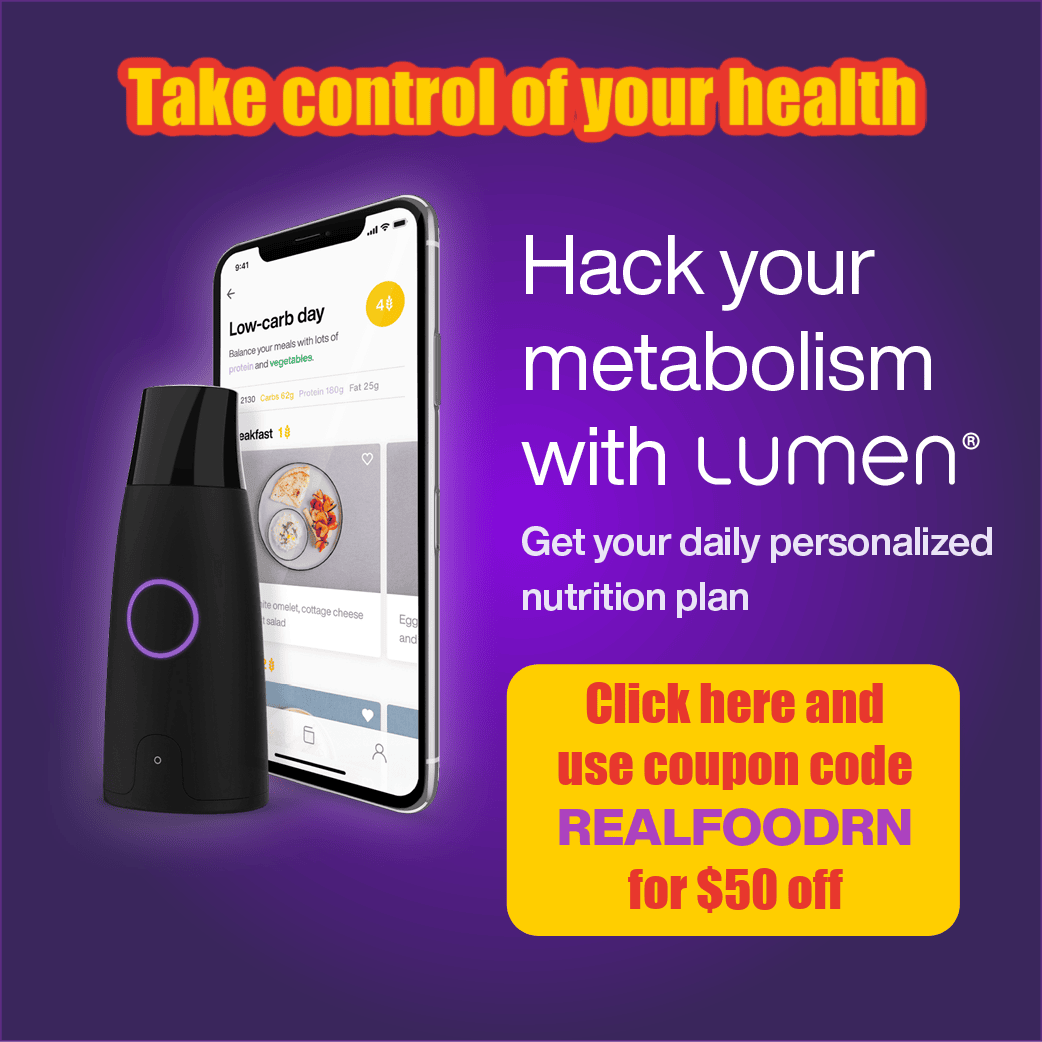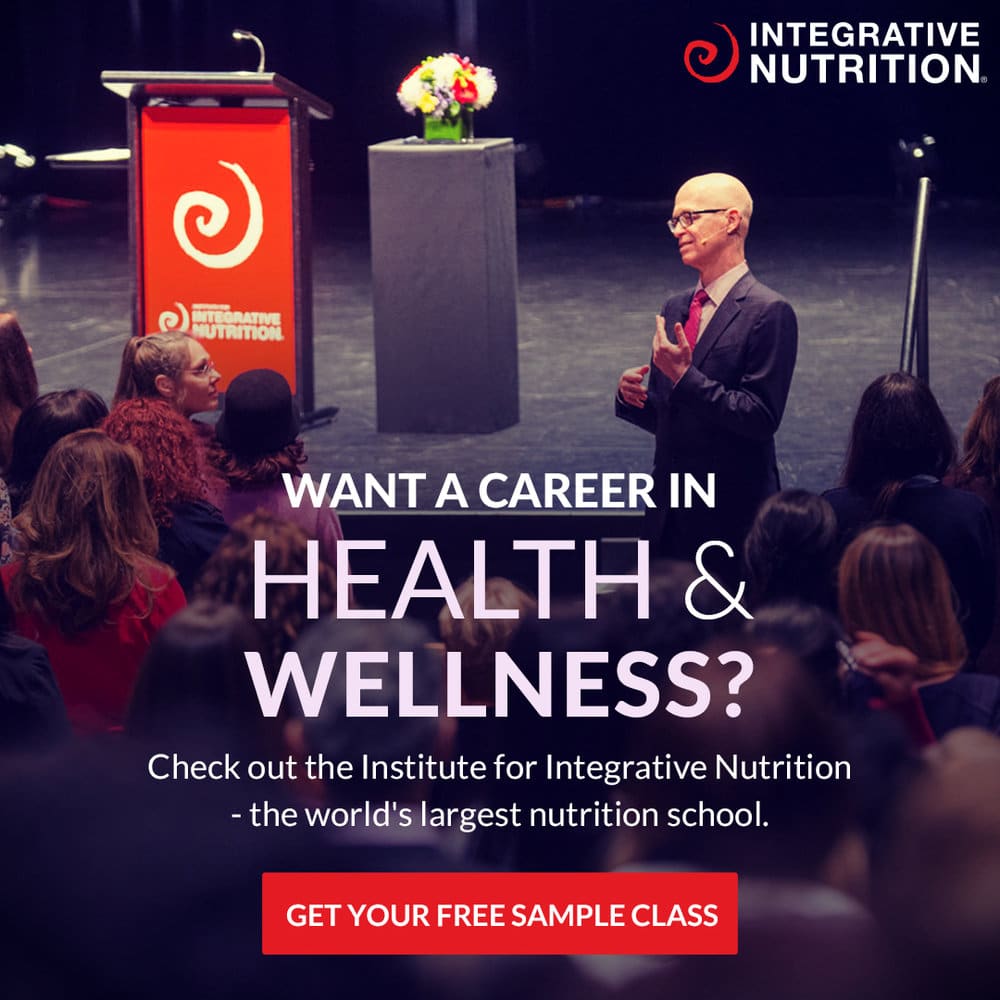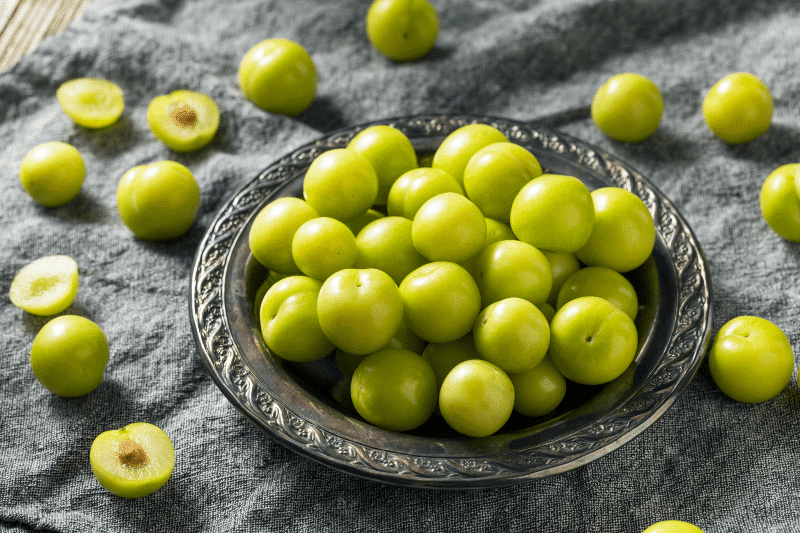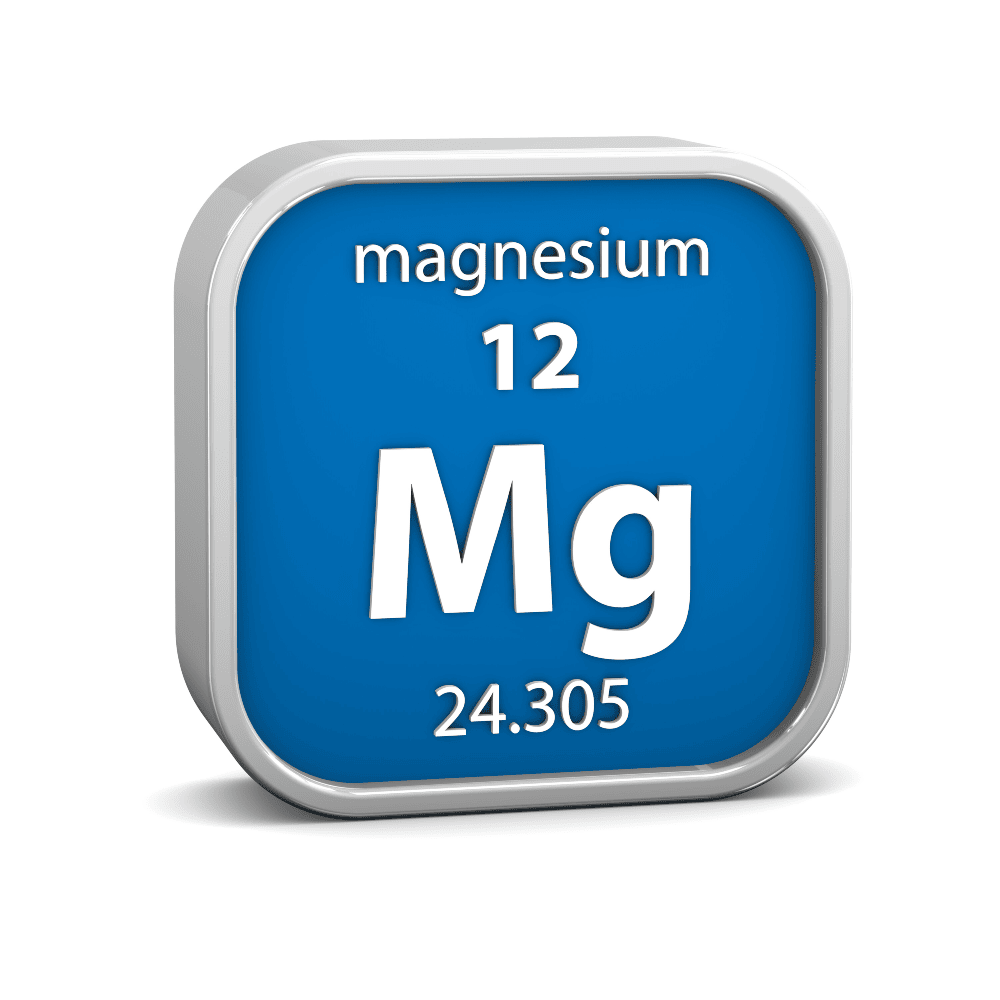More than 3,000 food additives — preservatives, flavorings, colors and other ingredients — are added to US foods, and this is one of the key reasons why I recommend avoiding most of the processed foods that contain them.
While many well-meaning nutritionists will teach you the importance of reading food labels, the easiest way to eat healthy is to stick with foods that need no food label at all… When was the last time you saw an ingredients list on a grass-fed steak or a bunch or broccoli?
There’s a good chance, though, that you do eat some processed foods, and if this is the case reading the label is invaluable. There are literally thousands of ‘red flags’ to watch out for in the foods you eat, but a handful take the proverbial cake for worst of the worst.
The Seven Worst Ingredients in Processed Foods
Andrea Donsky, founder of NaturallySavvy.com, did a wonderful job of highlighting seven ingredients you should avoid eating in the infographic above. She refers to them as the “Scary Seven.”1 If you see any of these on a food label, promptly put it back on the shelf; if you value your health, you don’t want to be putting these in your body. Let’s take a look at each in detail:
1. Artificial Sweeteners
Experiments have found that sweet taste, regardless of its caloric content, enhances your appetite, and consuming artificial sweeteners has been shown to lead to even greater weight gain than consuming sugar. Aspartame has been found to have the most pronounced effect, but the same applies for other artificial sweeteners, such as acesulfame potassium, sucralose and saccharin.
Yet, weight gain is only the beginning of why artificial sweeteners should generally be avoided. Aspartame, for instance, is a sweet-tasting neurotoxin. As a result of its unnatural structure, your body processes the amino acids found in aspartame very differently from a steak or a piece of fish.
The amino acids in aspartame literally attack your cells, even crossing the blood-brain barrier to attack your brain cells, creating a toxic cellular overstimulation, called excitotoxicity, similar to MSG.
Further, inflammatory bowel disease may be caused or exacerbated by the regular consumption of the popular artificial sweetener Splenda (sucralose), as it inactivates digestive enzymes and alters gut barrier function.2
Previous research also found that sucralose can destroy up to 50 percent of your beneficial gut flora.3 While you certainly don’t want to overdo it on sugar, there’s little doubt in my mind that artificial sweeteners can be even worse for your health than sugar and even fructose.
2. Synthetic Trans Fats
These are common in foods that contain partially hydrogenated vegetable oil, such as crackers, chips, most store-bought baked goods, and any fried foods, just to name a few examples. Synthetic trans fats are known to promote inflammation, which is a hallmark of most chronic and/or serious diseases.
For instance, in one 2010 study, post-menopausal women who consumed the most daily synthetic trans fat had a 30 percent higher incidence of ischemic strokes.4 Synthetic trans fats have also been linked to:
- Cancer: They interfere with enzymes your body uses to fight cancer.
- Diabetes: They interfere with the insulin receptors in your cell membranes.
- Decreased immune function: They reduce your immune response.
- Problems with reproduction: They interfere with enzymes needed to produce sex hormones.
- Heart disease
Your intake of trans fats should be as low as possible; no “safe upper limit” has even been established because, quite simply, there is none.
3. Artificial Flavors
What’s particularly alarming when you see a word like “artificial flavor” on an ingredients label is that there’s no way to know what it actually means. It could mean that one unnatural additive is included, or it could be a blend of hundreds of additives. Strawberry artificial flavor can contain nearly 50 chemical ingredients, for example.5
Or take the artificial flavoring called diacetyl, which is often used as a butter flavoring in microwave popcorn. Research shows diacetyl has several concerning properties for brain health and may trigger Alzheimer’s disease. Genetically engineered flavor enhancers can also be listed under the artificial flavor (or natural flavor) label.
4. Monosodium Glutamate (MSG)
This flavor enhancer is most often associated with Chinese food, but it’s actually in countless processed food products ranging from frozen dinners and salad dressing to snack chips and meats. MSG is an excitotoxin, which means it overexcites your cells to the point of damage or death, causing brain dysfunction and damage to varying degrees — and potentially even triggering or worsening learning disabilities, Alzheimer’s disease, Parkinson’s disease, Lou Gehrig’s disease and more.
Part of the problem is that free glutamic acid (MSG is approximately 78 percent free glutamic acid) is the same neurotransmitter that your brain, nervous system, eyes, pancreas and other organs use to initiate certain processes in your body. Although the US Food and Drug Administration (FDA) continues to claim that consuming MSG in food does not cause these ill effects, many other experts say otherwise.
5. Artificial Colors
Every year, food manufacturers pour 15 million pounds of artificial food dyes into U.S. foods — and that amount only factors in eight different varieties.6 As of July 2010, most foods in the European Union that contain artificial food dyes were labeled with warning labels stating the food “may have an adverse effect on activity and attention in children.” The British government also asked that food manufacturers remove most artificial colors from foods back in 2009 due to health concerns.
Nine of the food dyes currently approved for use in the US are linked to health issues ranging from cancer and hyperactivity to allergy-like reactions — and these results were from studies conducted by the chemical industry itself.7 For instance, Red # 40, which is the most widely used dye, may accelerate the appearance of immune system tumors in mice, while also triggering hyperactivity in children.
Blue # 2, used in candies, beverages, pet foods and more, was linked to brain tumors. And Yellow 5, used in baked goods, candies, cereal and more, may not only be contaminated with several cancer-causing chemicals, but it’s also linked to hyperactivity, hypersensitivity and other behavioral effects in children.
6. High-Fructose Corn Syrup (HFCS)
It’s often claimed that HFCS is no worse for you than sugar, but this is not the case. Because high-fructose corn syrup contains free-form monosaccharides of fructose and glucose, it cannot be considered biologically equivalent to sucrose (sugar), which has a glycosidic bond that links the fructose and glucose together, and which slows its break down in the body.
Fructose is primarily metabolized by your liver, because your liver is the only organ that has the transporter for it. Since all fructose gets shuttled to your liver, and, if you eat a typical Western-style diet, you consume high amounts of it, fructose ends up taxing and damaging your liver in the same way alcohol and other toxins do. And just like alcohol, fructose is metabolized directly into fat – it just gets stored in your fat cells, which leads to mitochondrial malfunction, obesity and obesity-related diseases.
The more fructose or HFCS a food contains, and the more total fructose you consume, the worse it is for your health. As a standard recommendation, I advise keeping your TOTAL fructose consumption below 25 grams per day. For most people it would also be wise to limit your fructose from fruit to 15 grams or less, as you’re virtually guaranteed to consume “hidden” sources of fructose if you drink beverages other than water and eat processed food.
Fifteen grams of fructose is not much — it represents two bananas, one-third cup of raisins, or two Medjool dates. Remember, the average 12-ounce can of soda contains 40 grams of sugar, at least half of which is fructose, so one can of soda alone would exceed your daily allotment.
7. Preservatives
Preservatives lengthen the shelf-life of foods, increasing manufacturers’ profits – at your expense, since most are linked to health problems such as cancer, allergic reactions and more. Butylated hydroxyanisole (BHA) and butylated hydrozyttoluene (BHT) are preservatives that affect the neurological system of your brain, alter behavior and have the potential to cause cancer. Tertiary butylhydroquinone (TBHQ) is a chemical preservative so deadly that just five grams can kill you.
The preservative sodium benzoate — found in many soft drinks, fruit juices and salad dressings – has been found to cause children to become measurably more hyperactive and distractible. Sodium nitrite, a commonly used preservative in hot dogs, deli meats and bacon, has been linked to higher rates of colorectal, stomach and pancreatic cancers. And the list goes on and on…
US Processed Foods May Be Even Worse Than Those in Other Countries
Many of the food additives that are perfectly legal to use in US foods are banned in other countries. The banned ingredients include various food dyes, the fat substitute Olestra, brominated vegetable oil, potassium bromate (aka brominanted flour), Azodicarbonamide, BHA, BHT, rBGH, rBST and arsenic.
When foods are processed, not only are valuable nutrients lost and fibers removed, but the textures and natural variation and flavors are also lost. After processing, what’s left behind is a bland, uninteresting “pseudo-food” that most people wouldn’t want to eat. So at this point, food manufacturers must add back in the nutrients, flavor, color and texture to processed foods in order to make them palatable, and this is why they become loaded with food additives. If you live in Europe, you may have more options than Americans, as you may be able to find some processed foods that do not contain any synthetic additives.
Still, swapping your processed food diet for one that focuses on fresh whole foods is a necessity if you value your health. Remember, people have thrived on vegetables, meats, eggs, fruits and other whole foods for centuries, while processed foods were only recently invented.
If you want to eat (and be) healthy, I suggest you follow the 1950s (and before) model and spend quality time in the kitchen preparing high-quality meals for yourself and your family. If you rely on processed inexpensive foods, you exchange convenience for long-term health problems and mounting medical bills. For a step-by-step guide to make this a reality in your own life, simply follow the advice in my optimized nutrition plan along with these seven steps to wean yourself off processed foods.
CLICK HERE to Pin this post
Original Source: Mercola
